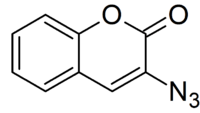3-Azidocoumarin
 | |
| Names | |
|---|---|
| IUPAC name
3-Azido-2H-chromen-2-one | |
| Identifiers | |
| 152711-55-2 | |
| 3D model (Jmol) | Interactive image |
| ChemSpider | 24771406 |
| |
| |
| Properties | |
| C9H6N3O2 | |
| Molar mass | 188.17 g·mol−1 |
| Appearance | Brown solid |
| Melting point | 108 to 112 °C (226 to 234 °F; 381 to 385 K) |
| Except where otherwise noted, data are given for materials in their standard state (at 25 °C [77 °F], 100 kPa). | |
| | |
| Infobox references | |
3-Azidocoumarin is an organic compound that is used in the area of bioconjugation. It is a derivative of coumarin, a natural product and precursor for the widely used Coumadin. Azidocoumarin has emerged as a widely applicable labeling agent in diverse biological systems. In particular, it participates in the aptly named click reaction with alkynes.[1] Bioconjugation involves the labeling of certain cellular components and is applicable to fields such a proteomics and functional genomics with a detachable, fluorescent tag.[2]
Synthesis
A common way to produce the 3-azidocoumarin is by condensation of salicylaldehyde and N-acetylglycine or nitroacetate.[3] The intermediate is trapped with sodium azide to produce the 3-azidocoumarin. The isomeric 4-azidocoumarin (CAS# 42373-56-8) product can also be prepared from 4-hydroxycoumarin via the 4-chloro derivative, which reacts with sodium azide.[4]
Uses
This compound is used for bioconjugation. The target, which contains a terminal alkyne functional group, is treated with the azide in the presence of a Cu(I) catalyst. The resulting 1,2,3-triazole is fluorescent. The coumarin backbone is chosen to be used as the profluorophore due to its small size, biocompatibility, and its ability to be easily manipulated synthetically.[3] Illustrative of this is the labeling of biological compounds such as the protein calmodulin.[5] Neither the azidocoumarin nor the alkyne substrate fluoresce. Azidocoumarin is also inert in biological systems and insensitive to pH and solvent. A variety of azidocoumarin compounds have been evaluated.
References
- ↑ R. A. Evans (2007). "The Rise of Azide–Alkyne 1,3-Dipolar 'Click' Cycloaddition and its Application to Polymer Science and Surface Modification". Aust. J. Chem. 60 (6): 384. doi:10.1071/CH06457.
- ↑ Hermanson, G. T. Bioconjugate Techniques; Academic Press: San Diego, 1996.
- 1 2 Q. Wang; et al. (2004). "A Fluorogenic 1,3-Dipolar Cycloaddition Reaction of 3-Azidocoumarins and Acetylenes". Org. Lett. 6 (24): 4603–4606. doi:10.1021/ol047955x.
- ↑ W. Stadlbauer (1986). "Methoden zur Darstellung von 4-Azido-2(1"H")-chinolonen [1]". Monatshefte für Chemie. 117 (11): 1305–1323. doi:10.1007/BF00810876.
- ↑ T. Fekner; X. Li; M. M. Lee & M. K. Chan (2009). "A Pyrrolysine Analogue for Protein Click Chemistry". Angew. Chem. Int. Ed. 48 (9): 1633–1635. doi:10.1002/anie.200805420. PMID 19156778.